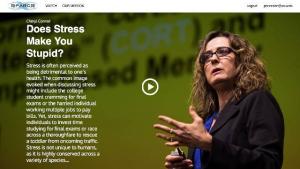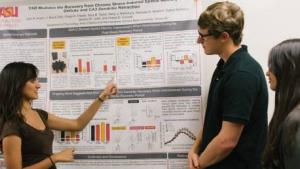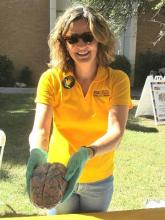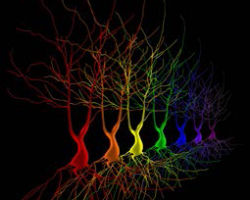
Behavioral Neuroscience Research in Stress (Conrad)
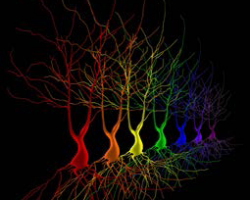
Our goal is to understand the mechanisms by which stress influences brain plasticity and resilience. The stress response is vital for organism survival and yet, a dysregulated stress response can be deadly. Understanding stress balance will be necessary for optimal health and survival. We have received funding from the National Institutes of Health and several foundations to study chronic stress and cognition in rodents. Research using chronic stress in animal models provides unique insights into the neurobiological underpinnings that could provide novel directions for therapeutic treatment. Current projects entail:
• Investigations into how gonadal hormones influence cognitive function when individuals are exposed to challenges, such as ongoing chronic stress, how these outcomes differ by sex.
• Using a rodent model to understand how middle-age and estrogen exposure in females influence depression and anxiety
• In collaboration with the Mayo Clinic, Scottsdale, investigating a rodent model of Alzheimer’s disease as it pertains to cognitive ability at different ages and changes in gene expression within the brainstem region, the Nucleus Incertus.
Lab Director and Principal Investigator:
Image
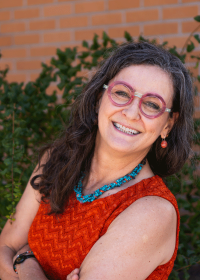
| Cheryl D. Conrad, PhD, Professor and Honors Disciplinary FacultyProfessor Conrad is a member of the Behavioral Neuroscience and Computation Psychology (BNCP) area and is affiliated with programs in the Molecular and Cellular Biology and Animal Behavior in the School of Life Sciences, and the interdisciplinary Neuroscience Program. Her passion is in neuroendocrine modulation of cognitive processes, with an emphasis on the stress system on memory and anxiety. She first studied auditory neuroplasticity with Dr. Norman Weinberger at the University of California, Irvine, earning two degrees in Biology and Chemistry. At the University of Illinois in Urbana-Champaign, Dr. Conrad worked with Dr. Edward Roy on the neuroendocrine (gonadal and adrenal) system influences on spatial cognition. As a postdoctoral fellow, Dr. Conrad worked with Dr. Bruce McEwen to investigate mechanisms of stress on spatial ability. Dr. Conrad has been at ASU since 1997 is passionate about her student’s training and success. |
Current Graduate Students
Image

| Antonio Gonzalez, First-year PhD student in behavioral neruoscience and comparative psychology |
Current Undergraduate Research Assistants
Image
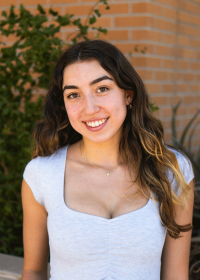
| Alyssa Bandin, Biological Sciences (biomedical sciences) with a certificate in evolutionary medicine |
Image
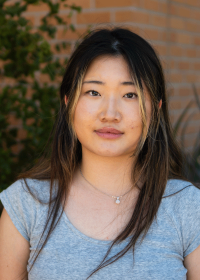
| Isabelle Lee, Biological sciences (neurobiology, physiology and behavior) |
Image

| Natalie Olson, Neuroscience with a minor in theatre |
Image

| Idaly Orrantia-Garcia, Neuroscience |
Image

| Sara Sladkova, Biologicial sciences and Barrett Honors student |
Image

| Mai Tang, Neuroscience and Psychology |
Our Lab Alums: where are they now?
Past Graduate and Postdoctoral Associates
- Dr. Dylan Peay, PhD 2023, currently at AZBio
- Dr. Jessica M. Judd ([email protected]), PhD 2020, currently a postdoctoral associate with Dr. Ramon Velazquez, BioDesign, ASU
- Dr. J. Bryce Ortiz, PhD 2017, currently a postdoctoral associate with Dr. Rachel Rowe, University of Arizona, College of Medicine, Phoenix
- Dr. Sara Taylor, 2012-2014, currently an Assistant Professor at Hendrix College, AR
- Dr. Annie Hoffman, Ph.D. 2013, currently a postdoctoral associate at UCLA
- Dr. Sarah Baran, Ph.D., 2008
- Dr. Katie McLaughlin, Ph.D., 2007, Medical Liaison, Eli Lilly & Co, IN
- Dr. Ryan Wright, Ph.D., 2007, Medical Science Liaison Director, Eli Lilly & Co, AZ
Undergraduate and Post-Bac Students Who Continued their Education
- Daniela Pacheco, graduated 2022, in PSYD clinical program, Midwestern University
- Amanda Acuña, graduated 2021, in PhD program, Interdisciplinary Neuroscience, ASU, AZ
- Megan Donnay, graduated 2020, started MD at the Mayo Clinic
- Cindy Reynolds, graduated 2020, in MS program Science of Heath Care Delivery, ASU, AZ
- Elliot Smith, graduated 2020, in PhD program, Interdisciplinary Neuroscience, ASU, AZ
- Jinah Kim, post-bac volunteer 2018-2000, in PhD program, Neuroscience, University of California, San Diego, CA
- Christopher Willis, graduated 2019, in MD program, St Louis University, St Louis, MO
- Vrishti Shah, graduated 2018, in MD program, University of Arizona, AZ
- Elizabeth Hanson, graduated 2018, in Program of Counseling, ASU
- Aaron Flegenheimer, graduated 2017, in MD program, Tulane School of Medicine, New Orleans, LA
- Brittany Le, graduated 2017, in Optometry Program, Western University of Health Sciences, Pomona, CA
- Diego Padilla-Garcia, post-bac volunteer 2016-2017, in PhD program in Psychological & Brain Sciences, University of California, Santa Barbara, CA
- Pooja Paode, graduated 2016, earned MS from Science of Health Care Delivery, ASU, AZ
- Kenji Nishimura, graduated 2016, in PhD program at the University of Texas, Austin
- Salma Kemmou, graduated 2015, earned MA from Global Affairs and Management, ASU, AZ
- Julia Anglin, graduated 2014, in PhD program, Computational Neuroscience, USC, Los Angeles, CA
- Jeffery Hanna, graduated 2012, earned MS in Clinical Translational Sciences, University of Arizona, AZ
- Danya Anouti, graduated 2012, earned MD from George Washington University, Washington, DC
- Agnieszka Mika, graduated 2011, earned PhD in Integrative Physiology and Neuroscience, University of Colorado, Boulder, CO
- Milica Miocevic, graduated 2011, earned PhD in Quantitative Psychology, ASU
- Charles Armstrong, graduated 2009, earned MD from University of Arizona, AZ
- Thu Huynh, post-bac volunteer 2007-2010, earned PhD in Neuroscience, New York University, NY
- Mariam El-Ashmawy, graduated 2008, University of Texas, Southwestern Med Ctr, Dallas, MD/PhD program
- Matthew Young, graduated 2008, earned PhD in Neuroscience, University of Pennsylvania, PA
- Jessica Wilson, graduated 2007, earned MD from University of Illinois, Chicago, IL
- Gillian Hamilton, graduated 2007, earned PhD in Psychology, University of Delaware, DE
- Juan Gomez, graduated 2006, earned PhD in Psychology, Hunter College, CUNY, NY
- James Harman, graduated 2005, earned DO from West Virginia School of Osteopathic Medicine
- Rudy Bellani, graduated 2005, earned PhD from The Rockefeller University, NY
- Cainan Foltz, graduated 2005, earned MD from Stanford University
- Jonathan Kleen, graduated 2005, earned PhD and MD at Dartmouth University, NH
- Elizabeth Lightner, graduated 2004, earned MD, University of Arizona, Tucson, AZ
- Sergey Tsekhanov, graduated 2004, earned DO, Touro University, NV
- Lindsay Wieczorek, graduated 2004, earned PhD at Washington University, MO
- Jamie Jackson, graduated 2002, earned PhD in Clinical Psychology, Ohio State University, OH
- Angelique Thomas-Ferayorni, graduated 2001, earned DO at Midwestern University, Phoenix, AZ
Impact of Chronic Stress on Hippocampal and Prefrontal Cortex Structure and Function
Conrad, C.D., Ortiz, J.B., & Judd, J.M. (2017). Chronic stress and hippocampal dendritic complexity: Methodological and functional considerations. Physiology & Behavior, 178, 66-81, Special issue in honor of “Randall Sakai.” DOI: 10.1016/j.physbeh.2016.11.017
Nishimura, K.J., Ortiz, J.B., & Conrad, C.D. (2017). Antagonizing the GABAA receptor during behavioral testing improves spatial memory in at different doses in control and chronically stressed rats. Neurobiology of Learning and Memory, 145 114-118. DOI: 10.1016/j.nlm.2017.09.002
Mika, A., Mazur, G.J., Hoffman, A.N., Talboom, J.S., Bimonte-Nelson, H.A., Sanabria, F., & Conrad, C.D. (2012). Chronic Stress Impairs Prefrontal Cortex-Dependent Response Inhibition and Spatial Working Memory. Behavioral Neuroscience, 126(5), 605-619. DOI: 10.1037/a0029642
Conrad, C.D. (2010). A critical review of chronic stress effects on spatial learning and memory. Invited review at Progress in Neuro-Psychopharmacology and Biological Psychiatry, 34, 742-755, special issue in the “Consequences of Stress.” DOI: 10.1016/j.pnpbp.2009.11.003
Conrad, C.D. (2006). What is the functional significance of chronic stress-induced CA3 dendritic retraction within the hippocampus? Behavioral and Cognitive Neuroscience Reviews, 5, 41-60. DOI: 10.1177/1534582306289043
Cognitive Sex Differences In Response To Chronic Stress
Peay, D.N., Saribekeyan, H.M., Parada, P.A. §, Hanson, E.M., Badaruddin, B.S., Judd, J.M., Donnay, M.E., Padilla-Garcia, D., and Conrad, C.D. (2020). Chronic unpredictable intermittent restraint stress disrupts spatial memory in male, but not female rats. Behavioural Brain Research, 383, 112519. DOI: 10.1016/j.bbr.2020.112519
Ortiz, J.B., Taylor, S.B., Hoffman, A.N., Campbell, A.N., Lucas, L.R., & Conrad, C.D. (2015). Sex-specific impairment and recovery of spatial learning following the end of chronic unpredictable restraint stress: Potential relevance of limbic GAD. Behavioural Brain Research, 282, 176-184. DOI: 10.1016/j.bbr.2014.12.051
Conrad, C.D., & Bimonte-Nelson, H.A. (2010). Impact of the Hypothalamic-Pituitary-Adrenal / Gonadal Axes on Trajectory of Age-Related Cognitive Decline. Progress in Brain Research, Martini, L., Ed. Elsevier. New York, NY, Vol 182, pp. 31-76. DOI: 10.1016/S0079-6123(10)82002-3
McLaughlin, K.J., Baran, S.E., & Conrad, C.D. (2009). Chronic Stress- and Sex-specific neuromorphological and functional changes in limbic structures. Molecular Neurobiology, 40, 166-82. DOI: 10.1007/s12035-009-8079-7
Stress and Estrogen Influences on the Brain and Behavior
Koebele, S.V., Nishimura, K.J., Bimonte-Nelson, H.A., Kemmou, S. Ortiz, J.B., Judd, J.M., and Conrad, C.D. (2020). Long-term cyclic plus tonic 17b-estradiol, but not cyclic 17b-estradiol alone, improves spatial working memory in ovariectomized middle-aged rats. Hormones & Behavior, 118, 104656. DOI: https://doi.org/10.1016/j.yhbeh.2019.104656
Ortiz, J.B., McLaughlin, K.J., Hamilton, G.F., Baran, S.E., Campbell, A.N., & Conrad, C.D. (2013). Cholesterol and perhaps estradiol protect against corticosterone-induced hippocampal CA3 dendritic retraction in gonadectomized female and male rats. Neuroscience, 246, 409-421.
DOI: 10.1016/j.neuroscience.2013.04.027
Conrad, C.D., McLaughlin, K.J., Huynh, T., El-Ashmawy, M., & Sparks, M. (2012). Chronic stress and a cyclic regimen of estradiol administration separately facilitate spatial memory: Relationship with CA1 spine density and dendritic complexity. Behavioral Neuroscience, 126(1), 142-156. DOI: 10.1037/a0025770
Neuroplasticity in the Aftermath Following Chronic Stress
Ortiz, J.B., Newbern, J., and Conrad, C.D. (2021) Chronic stress has different immediate and delayed effects on hippocampal calretinin- and somatostatin- positive cells. Hippocampus, 31(2) 221-231. DOI: 10.1002/hipo.23285
Ortiz, J.B. §, and Conrad, C.D. (2018) The impact from the aftermath of chronic stress on hippocampal morphology and function: Is there a recovery? Frontiers in Neuroendocrinology, 49, 114-123. DOI: 10.1016/j.yfrne.2018.02.005
Ortiz, J.B., Anglin, J.M., Daas, E.J., Paode, P.R., Nishimura, K.J., & Conrad, C.D. (2018). BDNF and TrkB mediate the improvement from chronic stress-induced spatial memory deficits and CA3 dendritic retraction. Neuroscience, 388, 330-346. DOI: 10.1016/j.neuroscience.2018.07.049
Ortiz, J.B., Mathewson, C.M., Hoffman, A.N., Hanavan, P.D., Terwilliger, E.F., & Conrad, C.D. (2014). Hippocampal brain derived neurotrophic factor mediates recovery from chronic stress-induced spatial reference memory deficits. European Journal of Neuroscience, 40, 3351-3362. DOI: 10.1111/ejn.12703
Chronic Stress In Rodents to Understand Depression
Huynh, T.N., Krigbaum, A.M., Hanna, J.J., & Conrad, C.D. (2011). Sex differences and phase of the light cycle modify chronic stress effects on anxiety and depressive-like behavior. Behavioural Brain Research, 222, 212-222. DOI: 10.1016/j.bbr.2011.03.038
Conrad, C.D., Ed., (2011) The Handbook of Stress: Neuropsychological Effects on the Brain, pp. 693. Wiley-Blackwell Publishers, New York, NY. Forward by Robert Sapolsky, Reviews from Drs. J McGaugh and M Dallman. DOI: 10.1002/9781118083222, ISBN: 978-1-4443-3023-6
Chronic Stress and Fear Conditioning To Understand Post-Traumatic Stress Disorder (PTSD)
Judd, J.M., Smith, E.A., Kim, J., Shah, V., Sanabria, F., and Conrad, C.D. (2020). Chronic stress has lasting effects on improved cued discrimination early in extinction. Learning & Memory, 27, 319-327. http://www.learnmem.org/cgi/doi/10.1101/lm.051060.119
Hoffman, A.N., Parga, A., Paode, P.R., Watterson, L.R., Nikulina, E.M., Hammer, Jr., R.P., & Conrad, C.D. (2015). Chronic stress enhanced fear memories are associated with increased amygdala zif268 mRNA expression and are resistant to reconsolidation. Neurobiology of Learning and Memory, 120, 61-68. DOI: 10.1016/j.nlm.2015.02.004
Hoffman, A.N., Lorson, N.G., Sanabria, F., Olive, M.F., & Conrad, C.D. (2014). Chronic stress disrupts fear extinction and enhances amygdala and hippocampal Fos expression in an animal model of post-traumatic stress disorder. Neurobiology of Learning and Memory, 112, 139-147. DOI: 10.1016/j.nlm.2014.01.018
ASU Now news story: Stressed out over your misplaced keys? Or is it the other way around? by Emma Greguska, 4/13/16.
The Behavioral Neuroscience group moved back into a newly renovated Psychology building in state-of-the-art facilities in August 2015! The layout of the wet labs and graduate/postdoctoral offices allows for frequent personnel interactions across research laboratories. Several sitting areas are strategically positioned to allow impromptu meetings in a relaxed, comfortable atmosphere. Designated testing rooms in a separate quarter provide quiet space for optimal testing of behavior.
On June 21, 2015, Cheryl Conrad was an invited speaker at the Society for the Promotion of Applied Research in Canine Science (SPARCS) and spoke on the topic of, “Does Stress Make You Stupid?” For more information, go to: http://www.sparcsinitiative.org/
Congratulations to Bryce Ortiz for acceptance in the Marine Biological Laboratory (MBL) 2015 Summer Program in Neuroscience, Ethics & Survival (SPINES) at Woods Hole! Bryce was among a few dozen graduate students, postdoctoral associates and junior faculty who were selected to participate in the prestigious summer program.
Congratulations to Pooja Paode (left) and Eshaan Daas for earning the School of Life Sciences Undergraduate Research (SOLUR) awards in 2015-2016! Pooja and Eshaan were undergraduate volunteers who were able earn a SOLUR standing based upon their academic success and research proposals! They also presented their work locally at ASU and nationally at the Society for Neuroscience conference in Chicago, 2015.
Brain Awareness activities are very important. We showcase our behavioral neuroscience research laboratory work to the community. All faculty, postdoctoral, graduate and undergraduate students volunteer at many events throughout the year. Cheryl Conrad (right) is showing an actual human brain to one of the visitors to the Psychology Booth at ASU Homecoming. We bake cookies to commemorate the event!
The Conrad team (below) attends conferences throughout the year to disseminate our findings, network with other neuroscientists, and learn about the newest discoveries and technologies.


